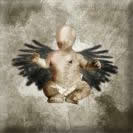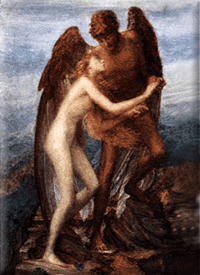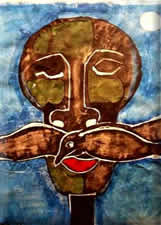The Forbidden Legacy of a Fallen Race
Part 1 | Part 2 | Part 3
 Angels are something we associate with beautiful Pre-Raphaelite and renaissance paintings, carved statues accompanying gothic architecture and supernatural beings who intervene in our lives at times of trouble. For the last 2000 years this has been the stereotypical image fostered by the Christian Church. But what are angels? Where do they come from, and what have they meant to the development of organised religion? Angels are something we associate with beautiful Pre-Raphaelite and renaissance paintings, carved statues accompanying gothic architecture and supernatural beings who intervene in our lives at times of trouble. For the last 2000 years this has been the stereotypical image fostered by the Christian Church. But what are angels? Where do they come from, and what have they meant to the development of organised religion?
Many people see the Pentateuch, the first five books of the Old Testament, as littered with accounts of angels appearing to righteous patriarchs and visionary prophets. Yet this is simply not so. There are the three angels who approach Abraham to announce the birth of a son named Izaac to his wife Sarah as he sits beneath a tree on the Plain of Mamre. There are the two angels who visit Lot and his wife at Sodom prior to its destruction. There is the angel who wrestles all night with Jacob at a place named Penuel, or those which he sees moving up and down a ladder that stretches between heaven and earth.
Yet other than these accounts, there are too few examples, and when angels do appear the narrative is often vague and unclear on what exactly is going on. For instance, in the case of both Abraham and Lot the angels in question are described simply as ‘men’, who sit down to take food like any mortal person.
Influence of the Magi
It was not until post-exilic times - i.e. after the Jews returned from captivity in Babylon around 450 BC - that angels became an integral part of the Jewish religion. It was even later, around 200 BC, that they began appearing with frequency in Judaic religious literature. Works such as the Book of Daniel and the apocryphal Book of Tobit contain enigmatic accounts of angelic beings that have individual names, specific appearances and established hierarchies. These radiant figures were of non-Judaic origin. All the indications are that they were aliens, imports from a foreign kingdom, namely Persia.
The country we know today as Iran might not at first seem the most likely source for angels, but it is a fact that the exiled Jews were heavily exposed to its religious faiths after the Persian king Cyrus the Great took Babylon in 539 BC. These included not only Zoroastrianism, after the prophet Zoroaster or Zarathustra, but also the much older religion of the Magi, the elite priestly caste of Media in north-west Iran. They believed in a whole pantheon of supernatural beings called ahuras, or ‘shining ones’, and daevas - ahuras who had fallen from grace because of their corruption of mankind.
Although eventually outlawed by Persia, the influence of the Magi ran deep within the beliefs, customs and rituals of Zoroastrianism. Moreover, there can be little doubt that Magianism, from which we get terms such as magus, magic and magician, helped to establish the belief among Jews not only of whole hierarchies of angels, but also of legions of fallen angels - a topic that gains its greatest inspiration from one work alone - the Book of Enoch.
The Book of Enoch
 Compiled in stages somewhere between 165 BC and the start of the Christian era, this so-called pseudepigraphal (i.e. falsely attributed) work has as its main theme the story behind the fall of the angels. Yet not the fall of angels in general, but those which were originally known as ’оrin (’оr in singular), "those who watch", or simply ‘watchers’ as the word is rendered in English translation. Compiled in stages somewhere between 165 BC and the start of the Christian era, this so-called pseudepigraphal (i.e. falsely attributed) work has as its main theme the story behind the fall of the angels. Yet not the fall of angels in general, but those which were originally known as ’оrin (’оr in singular), "those who watch", or simply ‘watchers’ as the word is rendered in English translation.
The Book of Enoch tells the story of how 200 rebel angels, or Watchers, decided to transgress the heavenly laws and ‘descend’ on to the plains and take wives from among mortal kind. The site given for this event is the summit of Hermon, a mythical location generally associated with the snowy heights of Mount Hermon in the Ante-Lebanon range, north of modern-day Palestine (but see below for the most likely homeland of the Watchers).
The 200 rebels realise the implications of their transgressions, for they agree to swear an oath to the effect that their leader Shemyaza would take the blame if the whole ill-fated venture went terribly wrong.
After their descent to the lowlands, the Watchers indulge in earthly delights with their chosen ‘wives’, and through these unions are born giant offspring named as Nephilim, or Nefilim, a Hebrew word meaning ‘those who have fallen’, which is rendered in Greek translations as gigantes, or ‘giants’.
Heavenly Secrets
In between taking advantage of our women, the 200 rebel angels spent their time imparting the heavenly secrets to those who had ears to listen. One of their number, a leader named Azazel, is said to have "taught men to make swords, and knives, and shields, and breastplates, and made known to them the metals (of the earth) and the art of working them", indicating that the Watchers brought the use of metal to mankind. He also instructed them on how they could make "bracelets" and "ornaments" and showed them how to use "antimony", a white brittle metal employed in the arts and medicine.
To the women Azazel taught the art of "beautifying" the eyelids, and the use of "all kinds of costly stones" and "colouring tinctures", presupposing that the wearing of make-up and jewellery was unknown before this age. In addition to these crimes, Azazel stood accused of teaching women how to enjoy sexual pleasure and indulge in promiscuity - a blasphemy seen as ‘godlessness’ in the eyes of the Hebrew storytellers.
Other Watchers stood accused of revealing to mortal kind the knowledge of more scientific arts, such as astronomy, the knowledge of the clouds, or meteorology; the "signs of the earth", presumably geodesy and geography, as well as the "signs", or passage, of the celestial bodies, such as the sun and moon. Their leader, Shemyaza, is accredited with having taught "enchantments, and rootcuttings", a reference to the magical arts shunned upon by most orthodox Jews. One of their number, Pкnкmыe, taught "the bitter and the sweet", surely a reference to the use of herbs and spices in foods, while instructing men on the use of "ink and paper", implying that the Watchers introduced the earliest forms of writing. Far more disturbing is Kвsdejв, who is said to have shown "the children of men all the wicked smitings of spirits and demons, and the smitings of the embryo in the womb, that it may pass away". In other words he taught women how to abort babies.
These lines concerning the forbidden sciences handed to humanity by the rebel Watchers raises the whole fundamental question of why angels should have possessed any knowledge of such matters in the first place. Why should they have needed to work with metals, use charms, incantations and writing; beautify the body; employ the use of spices, and know now to abort an unborn child? None of these skills are what one might expect heavenly messengers of God to possess, not unless they were human in the first place.
In my opinion, this revelation of previously unknown knowledge and wisdom seems like the actions of a highly advanced race passing on some of its closely-guarded secrets to a less evolved culture still striving to understand the basic principles of life.
More disconcerting were the apparent actions of the now fully grown Nephilim, for it says:
And when men could no longer sustain them, the giants turned against them and devoured mankind. And they began to sin against birds, and beasts, and reptiles, and fish, and to devour one another’s flesh, and drink the blood. Then the earth laid accusation against the lawless ones.
By now the cries of desperation from mankind were being heard loud and clear by the angels, or Watchers, who had remained loyal to heaven. One by one they are appointed by God to proceed against the rebel Watchers and their offspring the Nephilim, who are described as "the bastards and the reprobates, and the children of fornication". The first leader, Shemyaza, is hung and bound upside down and his soul banished to become the stars of the constellation of Orion. The second leader, Azazel, is bound hand and foot, and cast for eternity into the darkness of a desert referred to as Dыdвкl. Upon him are placed "rough and jagged rocks" and here he shall forever remain until the Day of Judgement when he will be "cast into the fire" for his sins. For their part in the corruption of mankind, the rebel Watchers are forced to witness the slaughter of their own children before being cast into some kind of heavenly prison, seen as an "abyss of fire".
Seven Heavens
The patriarch Enoch then enters the picture and, for some inexplicable reason, is asked to intercede on behalf of the incarcerated rebels. He attempts to reconcile them with the angels of heaven, but fails miserably. After this the Book of Enoch relates how the patriarch is carried by angels over mountains and seas to the "seven heavens". Here he sees multitudes of angelic beings watching stars and other celestial bodies in what appear to be astronomical observatories. Others tend orchards and gardens that have more in common with an Israeli kibbutz than an ethereal realm above the clouds.
Elsewhere in ‘heaven’ is Eden, where God planted a garden for Adam and Eve before their fall - Enoch being the first mortal to enter this domain since their expulsion.
Finally, during the life of Enoch’s great-grandson, Noah, the Great Flood covers the land and destroys all remaining traces of the giant race. Thus ends the story of the Watchers.
The Sons of God
What are we to make of the Book of Enoch? Are its accounts of the fall of the Watchers and the visits to heaven by the patriarch Enoch based on any form of historical truth? Scholars would say no. They believe it to be a purely fictional work inspired by the Book of Genesis, in particular two enigmatic passages in Chapter 6. The first, making up Verses 1 and 2, reads as follows:
And it came to pass, when men began to multiply on the face of the ground, and daughters were born unto them, that the sons of God saw the daughters of men that they were fair; and they took them wives of all that they chose.
By ‘sons of God’ the text means heavenly angels, the original Hebrew being bene ha-elohim. In Verse 3 of Chapter 6 God unexpectedly pronounces that his spirit cannot remain in men for ever, and that since humanity is a creation of flesh its life-span will henceforth be shortened to "an hundred and twenty years". Yet in Verse 4 the tone suddenly reverts to the original theme of the chapter, for it says:
The Nephilim were in the earth in those days, and also after that, when the sons of God came in unto the daughters of men, and they bare children to them: the same were the mighty men which were of old, the men of renown.
As the Pentateuch is considered to have been written by Moses the lawgiver in c.1200 BC, it is assumed that the lines of Genesis 6 influenced the construction of the Book of Enoch, not the other way round. Despite this obvious assumption on the part of Hebrew scholars, there is ample evidence to show that much of Genesis was written after the Jews return from captivity in Babylon during the mid-fifth century BC. If this was the case, then there is no reason why the lines of Genesis 6 could not have been tampered with around this time. In an attempt to emphasise the immense antiquity of the Book of Enoch, Hebrew myth has always asserted that it was originally conveyed to Noah, Enoch’s great grandson, after the Great Flood, i.e. long before the compilation of Genesis. This claim of precedence over the Pentateuch eventually led the Christian theologian St Augustine (AD 354-430) to state that the Book of Enoch was too old (ob nimiam antiquitatem) to be included in the Canon of Scripture!
Roots of the Nephilim
There is another enigma contained within the lines of Genesis 6, for its appears to embody two entirely different traditions.
Look again at the words of Verse 2. They speak of the Sons of God coming unto the Daughters of Men, while in contrast Verse 4 states firmly: "The Nephilim were in the earth in those days and also after that when the sons of God came in unto the daughters of men (author’s emphasis)".
And also after that...
The meaning seemed clear enough: there were two quite separate traditions entangled here - one concerning the fallen race known to the early Israelites as the Nephilim (mentioned elsewhere in the Pentateuch as the progenitors of a race of giants called Anakim), and the other concerning the bene ha-elohim, the Sons of God, who are equated directly with the Watchers in Enochian tradition. Theologians are aware of this dilemma, and get around the problem by suggesting that the angels fell from grace twice - once through pride and then again through lust. It seems certain that the term Nephilim was the original Hebrew name of the fallen race, while bene ha-elohim was a much later term - plausibly from Iran - that entered Genesis 6 long after its original compilation.
In spite of the contradictions surrounding Genesis 6, its importance is clear enough, for it preserved the firm belief among the ancestors of the Jewish race that at some point in the distant past a giant race had once ruled the earth.
So if the Watchers and the Nephilim really had inhabited this world, then who or what were these seemingly physical beings? Where did they come from? What did they look like? Where did they live and what was their ultimate fate?
The Book of Enoch was a vital source of knowledge with regard to their former existence, but I needed more - other less tainted accounts of this apparent race of human beings.
Then came an important break.
The Dead Sea Connection
Hebrew scholars had long noted the similarities between some of the reactionary teachings in the Book of Enoch and the gospels according to the Essenes - a fundamental, yet very righteous religious community spoken of by classical scholars as having existed on the western shores of the Dead Sea. This connection was strengthened after 1947 when it was realised that among the Dead Sea Scrolls, now considered to have been written by the Essenes, were various fragments of texts belonging to several copies of the Book of Enoch. Up until this time the only complete manuscript copies available to the literary world had been various copies written in the Ethiopian written language of Ge’ez, the first of which had been brought back to Europe by the Scottish explorer and known Freemason James Bruce of Kinnaird following his famous travels in Abysinnia between 1769 and 1772.
Not only did the Dead Sea Scrolls confirm the authenticity of the Book of Enoch, but they also showed that it had been held in great esteem by the Essene community at Qumran, who may even have been behind its original construction sometime after 165 BC. More importantly, Hebrew scholars also began to identify various other previously unknown tracts of an ‘Enochian’ flavour among the Dead Sea corpus, and these included further references to the Watchers and their offspring the Nephilim. Many of these individual fragments were eventually realised by Dead Sea scholar J.T. Milik to be extracts from a lost work called the Book of Giants.
Previously this had only been known from isolated references in religious texts appertaining to the Manichaeans, a heretical gnostic faith that swept across Europe and Asia, as far as China and Tibet, from the third century AD onwards.
The Book of Giants continues the story told in the Book of Enoch, relating how the Nephilim had coped with knowing that their imminent destruction was due to the improprieties of their Watcher fathers. Reading this ancient work allows the reader a more compassionate view of the Nephilim, who come across as innocent bystanders in a dilemma beyond their personal control.
Visage Like A Viper
Yet aside from this still very fragmentary treatise, other Enochian texts have surfaced among the Dead Sea Scrolls which in my opinion are just as important. One of these is the Testament of Amram.
Amram was the father of the lawgiver Moses, although any biblical time-frame to this story is irrelevant. What is much more significant is the appearance of the two Watchers who appear to him in a dream-vision as he rests in his bed, for as the heavily reconstructed text reads:
[I saw Watchers] in my vision, the dream-vision. Two (men) were fighting over me, saying... and holding a great contest over me. I asked them, ‘Who are you, that you are thus empo[wered over me?’ They answered me, ‘We] [have been em]powered and rule over all mankind.’ They said to me, ‘Which of us do yo[u choose to rule (you)?’ I raised my eyes and looked.] [One] of them was terr[i]fying in his appearance, [like a s]erpent, [his] c[loa]k many-coloured yet very dark... [And I looked again], and... in his appearance, his visage like a viper, and [wearing...] [exceedingly, and all his eyes...].
The text identifies this last Watcher as Belial, the Prince of Darkness and King of Evil, while his companion is revealed as Michael, the Prince of Light, who is also named as Melchizedek, the King of Righteousness. It is, however, Belial’s frightful appearance that took my attention, for he is seen as terrifying to look upon and like a ‘serpent’, the very synonym so often used when describing both the Watchers and the Nephilim. If the textual fragment had ended here, then I would not have known why this synonym had been used by the Jewish scribe in question. Fortunately, however, the text goes on to say that the Watcher possessed a visage, or face, "like a viper". Since he also wears a cloak "many-coloured yet very dark", I had also to presume that he was anthropomorphic, in other words he possessed human form.
Visage like a viper...
What could this possibly mean? How many people do you know with a "visage like a viper"? For over a year I could offer no suitable solution to this curious metaphor.
Then, by chance, I happened to overhear something on a national radio station that provided me with a simple, though completely unexpected answer. In Hollywood, Los Angeles, there is a club called the Viper Room. It is owned by actor and musician Johnny Depp, and in October 1993 it hit the headlines when up-coming actor River Phoenix tragically collapsed and died as he left the club following a night of over-indulgence. In the media publicity that inevitably surrounded this drugs-related incident, it emerged that the Viper Room gained its name many years beforehand when it had been a jazz haunt of some renown. Story goes that the musicians would take the stage and play long hours, prolonging their creativity and concentration by smoking large amounts of marijuana. Apparently, the long term effects of this drug abuse, coupled with exceedingly long periods without food and sleep, would cause their emaciated faces to appear hollow and gaunt, while their eyes would close up to become just slits. Through the haze of heavy smoke, the effect was to make it seem as if the jazz musicians had faces like vipers, hence the name of the club.
This amusing anecdote sent my mind reeling and enabled me to construct a mental picture of what a person with a "visage like a viper" might look like; their faces would appear long and narrow, with prominent cheekbones, elongated jawbones, thin lips and slanted eyes like those of many East Asian racial types. Was this the solution as to why both the Watchers and Nephilim were described as walking serpents? It seemed as likely a possibility as any, although it was also feasible that their serpentine connection related to their accredited magical associations and capabilities, perhaps even their bodily movements and overall appearance.
The Appearance of Feathers
Another important reference to the appearance of Watchers comes from the so-called Secrets of the Book of Enoch, also known as 2 Enoch, a kind of sequel to the original work written in Greek and dating to the first century AD. The passage refers to the unexpected arrival of two Watchers as Enoch rests on his bed:
And there appeared to me two men very tall, such as I have never seen on earth. And their faces shone like the sun, and their eyes were like burning lamps; and fire came forth from their lips. Their dress had the appearance of feathers:... [purple], their wings were brighter than gold; their hands whiter than snow. They stood at the head of my bed and called me by my name.
White skin (often ruddied "as red as a rose"), tall stature and facial radiances "like the sun" all recur frequently in connection with the appearance of angels and Watchers in Enochian and Dead Sea literature. Yet what was this reference to their dress having "the appearance of feathers"? Might it relate in some way to the "cloak" worn by the Watcher named Belial who appears in the Amram story, which was said to have been "many-coloured yet very dark", precisely the effect one might expect from a coat of black feathers, like those belonging to crows or vultures perhaps?
In spite of the fact that Christian art has invariably portrayed angels with wings, this tradition goes back no further than the third or fourth century AD. Before this time true angels (Cherubim and Seraphim did have multiple sets of wings) appeared in the likeness of "men", a situation that often prompted textual translators to add wings on to existing descriptions of angels. This has almost certainly been the case in the above account taken from 2 Enoch, which was re-copied many times during the early years of Christianity.
With this observation in mind, I felt that the statement concerning the Watchers dress having "the appearance of feathers" was very revealing indeed. It also seemed like an over-sight on the part of the scribe who conveyed this story into written form, for having added wings to the description of the two "men", why bother saying they wore garments of feathers? Surely this confusion between wings and feather coats could have been edited to give the Watchers a more appropriate angelic appearance.
Bird Shamans
 Somehow I knew it was a key to unlocking this strange mystery, for it suggested that, if the Watchers had indeed been human, then they may have adorned themselves in garments of this nature as part of their ceremonial dress. The use of totemic forms, such as animals and birds, has always been the domain of the shaman, the spirit walkers of tribal communities. In many early cultures the soul was said to have taken the form of a bird to make its flight from this world to the next, which is why it is often depicted as such in ancient religious art. This idea may well have stemmed from the widely-held belief that astral flight could only be achieved by using ethereal wings, like those of a bird, something that almost certainly helped inspire the idea that angels, as messengers of God, should be portrayed with wings in Christian iconography. Somehow I knew it was a key to unlocking this strange mystery, for it suggested that, if the Watchers had indeed been human, then they may have adorned themselves in garments of this nature as part of their ceremonial dress. The use of totemic forms, such as animals and birds, has always been the domain of the shaman, the spirit walkers of tribal communities. In many early cultures the soul was said to have taken the form of a bird to make its flight from this world to the next, which is why it is often depicted as such in ancient religious art. This idea may well have stemmed from the widely-held belief that astral flight could only be achieved by using ethereal wings, like those of a bird, something that almost certainly helped inspire the idea that angels, as messengers of God, should be portrayed with wings in Christian iconography.
To enhance this mental link with his or her chosen bird, shamans would adorn their bodies with a coat of feathers and spend long periods of time studying its every movement. They would enter its natural habitat and watch every facet of its life - its method of flight, its eating habits, its courtship rituals and its actions on the ground. In doing so they would hope to become as birds themselves, an alter-personality adopted on a semi-permanent basis. Totemic shamanism is more-or-less dependent on the indigenous animals or birds present in the locale of the culture or tribe, although in principle the purpose has always been the same - using this mantle to achieve astral flight, divine illumination, spirit communication and the attainment of otherworldly knowledge and wisdom.
So could the Watchers and Nephilim have been bird-men?
The answer is almost certainly yes, for in the Dead Sea text entitled the Book of Giants, the Nephilim sons of the fallen angel Shemyaza, named as ’Ahyв and ’Ohyв, experience dream-visions in which they visit a world-garden and see 200 trees being felled by heavenly angels. Not understanding the purpose of this allegory they put the subject to the Nephilim council who appoint one of their number, Mahawai, to go on their behalf to consult Enoch, who now resides in an earthly paradise. To this end Mahawai then:
[...rose up into the air] like the whirlwinds, and flew with the help of his hands like [winged] eagle [...over] the cultivated lands and crossed Solitude, the great desert, [...]. And he caught sight of Enoch and he called to him...
Enoch explains that the 200 trees represent the 200 Watchers, while the felling of their trunks signifies their destruction in a coming conflagration and deluge. More significant, however, is the means by which Mahawai attains astral flight, for he is said to have used "his hands like (a) [winged] eagle." Elsewhere in the same Enochian text Mahawai is said to have adopted the guise of a bird to make another long journey. On this occasion he narrowly escapes being burnt up by the sun’s heat and is only saved after heeding the celestial voice of Enoch, who convinces him to turn back and not die prematurely - a story that has close parallels with Icarus’s fatal flight too near the sun in Greek mythology.
In addition to this evidence, a variation of this same text equates Shemyaza’s sons "not (with) the... eagle, but his wings", while in the same breath the two brothers are described as "in their nest", statements which prompted the Hebrew scholar J.T. Milik to conclude that, like Mahawai, they too "could have been bird-men".
This was compelling confirmation that angels were originally a culture or tribe who practised a form of bird shamanism, perhaps associated with a dark carrion bird such as the crow or vulture.
Part 1, 2, 3 | -->
|

